Suonobuono Lazer Handleiding
Suonobuono
DJ Gear
Lazer
Bekijk gratis de handleiding van Suonobuono Lazer (3 pagina’s), behorend tot de categorie DJ Gear. Deze gids werd als nuttig beoordeeld door 63 mensen en kreeg gemiddeld 4.5 sterren uit 32 reviews. Heb je een vraag over Suonobuono Lazer of wil je andere gebruikers van dit product iets vragen? Stel een vraag
Pagina 1/3

Foreword
Suonobuono is my attempt to share innovative products with other music
enthusiasts Managing all aspects of this company, from early design to .
products manufacturing, from logistics to marketing, has taken me great
deals of time energy. Musicians like you, who care about creativity and and
support independent realities make it all worth it, THANK YOU!
I hope that you will enjoy your new Lazer and really recommend reading
this short manual to get the most out of it.
Stefano Sorrentino, founder, Suonobuono AB
Cleaning and maintenance
It is recommended to cover Lazer when it is not used, so that dust does not
deposit on the lens.
If the case becomes dirty, wipe it with a clean, dry cloth. Do not use liquid
cleaners such as benzene or thinner, or cleaning compounds or flammable
polishes.
Be particularly careful not to scratch the laser optics You may use a .
dry soft cotton bud to wipe away dust from the laser lens, using great
care to not scratch the lens and to not apply force e optics. to th
Product Warranty
The warranty covers all defects in material and workmanship for a period of
two years from the date of original purchase. During this time, Suonobuono
AB will repair or replace the product without charge for materials or labor,
provided the product was first inspected and found faulty by Suonobuono.
You must first contact Suonobuono AB by email. Products that were mailed
without prior agreement cannot be exchanged or repaired free of charge.
The unit must be insured and sent prepared in its original package. Please
include a detailed description of the defect. Suonobuono AB reserves the
right to upgrade the unit if necessary. This warranty does not cover defects
due to abuse, operation under other than specified conditions, or repair by
unauthorized persons. The warranty covers only those malfunctions
caused by material or workmanship defects that occur during normal
operation. Units that have been opened, modified or exposed to unusual
stress and conditions are not covered by the warranty.
If you have any questions about your Suonobuono product, feel free to
send an email to info (at) suonobuono.net
Precautions
Location: Using the unit in the following locations can result in a
malfunction
• In direct sunlight
• Locations of extreme temperature or humidity
• Excessively dusty or dirty locations
• Locations of excessive vibration
Power supply: Lazer is powered from the USB connector. Connect a USB
2.0 compliant power bank or USB host. Do not connect any power source
that is not a USB 2.0 compliant power source. Using a different power
supply than the recommended one may result in device damage and could
cause a breakdown, fire, or electrical shock.
Handling: To avoid breakage, do not apply excessive force to the switches
or controls.
Care: Do not open or modify this product, since doing so may result in
safety hazards and will automatically invalidate the product guarantee.
Installing firmware not officially released by Suonobuono AB on this product
will also void the product guarantee and may result in safety hazards.
Keeping foreign matter out of your equipment: Never set any container
with liquid in it near this equipment. If liquid gets into the equipment, it could
cause a breakdown, fire, or electrical shock. Be careful not to let metal
objects get into the equipment. If something does slip into the equipment,
unplug the power supply immediately and contact Suonobuono for
assistance.
Headphones volume: the PHONES output can deliver very loud sound
level on headphones, which may damage hearing. Always set a low
Phones Volume level on Lazer before connecting headphones and before
wearing them.
Keep this manual: After reading this manual, please keep it for later
reference.
Laser safety considerations
This device contains a laser emitter and corresponding drive circuitry. The
laser output is designed to remain within Class 1 laser safety limits under
all reasonably foreseeable conditions including single faults in compliance
with IEC 60825-1:2014 (third edition).
The laser output remains within Class 1 limits as long as the recommended
device settings are used and the operating conditions specified in this
manual are respected.
The laser output power must not be increased by any means and no optics
should be used with the intention of focusing the laser beam.
Use of controls or adjustments or performance of procedures other than
those specified herein may result in hazardous radiation exposure.
The laser emitter included in this device uses invisible light. Avoid looking
directly into the emitter during operation and absolutely avoid using any
optics that may focus the laser beam into the eye.
Unauthorized modifications of the firmware, electronics, optics or enclosure
of the device may alter the level or duration of laser emissions and
generate a safety hazard. Only firmware updates that are officially released
by Suonobuono should be used, and no modification of any hardware part
of the device should be attempted by anyone not explicitly authorized by
Suonobuono.
Suonobuono takes no responsibility for any damage deriving from not
following the safety recommendations provided in this manual, or from any
modifications to the device.
Declaration of conformity
Important notice: DO NOT MODIFY THE UNIT!
USA:
This product, when installed as indicate in the instructions contained in this
manual, meets FCC requirement. Modifications not expressly approved by
Suonobuono AB may avoid your authority, granted by the FCC, to use the
product.
IMPORTANT: When connecting this product to accessories and/or another
product, use only high quality shielded cables. Cable(s) supplied with this
product must be used. Follow all installation instructions. Failure to follow
instructions could void your FFC authorization to use this product in the
USA.
NOTE: This product has been tested and found to comply with the limit for
a Class B Digital device, pursuant to Part 15 of the FCC rules. These limits
are designed to provide a reasonable protection against harmful
interference in a residential environment. This equipment generates, uses
and radiates radio frequency energy and, if not installed and used
according to the instructions found in the user manual, may cause
interferences harmful to the operation to other electronic devices.
Compliance with FCC regulations does not guarantee that interferences will
not occur in all the installations. If this product is found to be the source of
interferences, which can be determined by turning the unit “OFF” and “ON”,
please try to eliminate the problem by using one of the following measures:
• Relocate either this product or the device that is affected by the
interference.
• Use power outlets that are on different branch (circuit breaker or
fuse) circuits or install AC line filter(s).
• In the case of radio or TV interferences, relocate/ reorient the
antenna. If the antenna lead-in is 300 ohm ribbon lead, change
the lead-in to coaxial cable.
• If these corrective measures do not bring any satisfied results,
please contact Suonobuono AB .
The above statements apply ONLY to those products distributed in the
USA.
EUROPE
This product complies with the requirements of European Directive
89/336/EEC This product may not work correctly by the influence of
electro-static discharge; if it happens, simply restart the product.
Disposal
You must dispose the product in the correct manner to avoid harm to
human health or damage to the environment. Contact your local
administrative body for details on the correct disposal method.
suonobuono lazer- user manual
suonobuono lazer- user manual
suonobuono lazer- user manual
suonobuono lazer- user manual suonobuono lazer- user manual

Overview
Lazer measures the distance between your hand and its sensor, and it
transforms it into analog (gate/cv), MIDI (DIN and USB) and audio signals. The
blue led intensity proportional to the controlled parameter and it blinks when is
your hand is beyond the configured Distance range. The red led turns on if your
hand is within the configured Distance range.
For best results, use a wide, flat object, such as your hand palm, and keep it
parallel to Lazer, vertically aligned with the sensor. Accuracy degrades with
strong ambient light (e.g., in sunlight) and with larger distance. To improve
accuracy, you may attach reflex material or reflexive tape to your palm or your
finger. For normal indoor use, this should not be necessary.
The measured distance can be mapped to different types of output:
• MIDI control chang pitch bende or : map distance to a MIDI message. For
example, you can create a slide effect with pitch bend or you can control any
MIDI control change-mapped parameter on a synth or effect.
• MIDI notes: trigger different notes (with optional pitch bend) on a MIDI
instrument
• MIDI start/stop and MIDI/analog tempo: control a sequencer with your
hand. Change the tempo based on distance.
• Analog cv/gate: control cv-controllable parameters on an analog synthesizer. The gate can be used to
trigger notes, drums, envelopes and events every time the hand is detected
• Audio out: this lo-fi oscillator is primarily intended to provide a reference pitch, but it can even be used
as a Theremin-style oscillator or for fx.
Presets list and using presets
Lazer supports 10 presets, out of which 5 are read-only and factory-delivered, and the remaining ones can be
overwritten by the user. The factory presets are intended as templates for common configurations:
• Param mod up: send MIDI control change 74 (often associated to cutoff filter) values in range 0-127
and CV in range 0-5V, so that values increase with distance. the hand is removed, the value When
corresponding to maximum distance is sent.
• Param mod d now : same as Param mod up, but values decrease with distance.
• Pitch bend: send negative pitch bend values and lower CV when hand is lowered.
• 1 octave Therem: trigger notes over one octave range with continuous pitch.
• Seq.Ctrl+cc74: send start/stop sequencer control MIDI messages, send MIDI clock and send MIDI
control change . 74
Parameters and customization
Presets are just a starting point. To get the most out of your Lazer, you should get familiar with all its parameters,
it only takes some minutes!
• 2-MIDI/An.Ctrl: you can send y control change (CC) 0-119, Notes On/Off and Pitch bend. You an
should select the control change that is associated to the desired parameter on the controlled
instrument. For example, CC 74 is often associated to filter cutoff.
• 3-Direction: decide if the controlled MIDI value and CV should increase or decrease with hand
distance.
• 4-MIDI min value: this is the lowest note or CC value that will be sent
• 5-MIDI max value: this is the highest note or CC value that will be sent
• 6-Quant level: this is the level of quantization (0-5) of the MIDI Notes and analog cv output. When set
to 0, no quantization is applied and Notes smoothly glide from one to the next one. When set to 10, note
pitches are approximated to the nearest semitone. Intermediate values give a “soft” auto-tune.
o Important: the MIDI instrument pitch bend range must be set to +/-2 semitones,
otherwise the notes will not glide smoothly.
• 7-Accuracy: control the trade-off between sensor speed and accuracy. Tips:
o For triggering drum sounds, select Fast
o For precisely controlling parameters over a wide range, select Accurate
o Balanced should be a good compromise in most other situations
• 8-Tempo: sets the tempo sent by Lazer when 2-MIDI/An.Ctrl is in Seq. mode.
• 9-MIDI channel: the channel used for all MIDI transmissions. The receiving device must listen to the
same channel.
• 10-Phones volume: the volume of the PHONES out. This can be loud, so always start from a low
value!
o Tip: if you are using the PHONES output to feed a line input, it is recommended to use a high
Phones volume level to maximize audio quality
• 11-Tune: adjust tuning for the internal audio oscillator
• 12-Dist. Range: Maximum distance at which the control signals are generated. The full range of values
between Midi min value and MIDI max value happens between 0 and Dist. Range.
Connections
• The port should be connected to a suitable USB 2.0-compliant power source such as a power USB
bank, a phone charger or a computer. Lazer transmits the same MIDI messages over its MIDI output
and its USB port. If you don’t need to read MIDI from the USB port, I recommend powering Lazer from a
dedicated phone charger or power bank, to avoid potential ground loop noise.
• The and CV GATE outputs deliver analog signals (0-5V) for controlling analog and modular
synthesizers using mono 3.15mm jack cables (not provided).
• The PHONES out delivers an audio signal whose MIDI pitch matches the controlled parameter MIDI
value. For example, MIDI value 48 corresponds to C3 and 60 to C4. At high volume, the PHONES out
can sound very loud on headphones! Always set a very low volume level on Lazer, before
connecting your headphones and then wearing them.
• The MIDI output needs to be connected to the provided TRS to DIN MIDI cable, and from there to a
device MIDI IN.
Menu navigation
The menu shows two rows:
• The first row is the name of the selected menu item
• The second row is the value for the selected menu item
The selected row is highlighted on the display. To switch row, briefly push the +/- buttons together. Use the +/-
buttons to adjust values. To scroll values faster, long press + or -.
To load a preset: select the Preset menu item and switch row. Select the desired preset, then press + for 3
seconds. After releasing, the leds will blink to indicate that the preset has been loaded.
To save a preset, long press - for 3 seconds while the target preset is highlighted. Only user presets may be
overwritten.
To turn Lazer off, long press + and simultaneously for 3 seconds. Lazer shuts down automatically also when –
the USB host sends a power off USB command.
To turn Lazer on again, press any button. Lazer restarts with the same settings as when it was turned off
regularly.

Some usage examples
Analog/MIDI/USB parameter and pitch bend control
Analog instruments control
MIDI and USB-MIDI parameter/pitch bend control
Continuous pitch (Theremin-like)
Trigger a sequencer/drum machine with MIDI
Control an analog sequencer
Functionality:
-Adjust analog/MIDI parameters or
pitch bend
Connections:
- MIDI out to the instrument or effect
MIDI input, using the included TRS
to DIN adapter
-USB port to a computer running a
DAW
- Analog CV/GATE to analog inputs
Tip! Powering with a phone charger
or power bank prevents ground loop
noise
Important parameters:
- : decide if the paramDirection eter
should increase or decrease with
hand distance
-Accuracy: prioritize between latency
or distance accuracy
- : choose between a MIDI/analog ctrl
target Control Change (CC) [1-119]
and Pitchbend
-MIDI min/max value: adjust the
range of MIDI CC values
- I channel MID
-Dist. range
Reference presets:
-Param mod up, Param mod down,
Pitch bend
Functionality:
- Adjust parameters
-Trigger events whenever your hand
is detected
Connections:
-CV and/or GATE to analog inputs
on a modular synthesizer
Tip! Powering with a phone charger
or power bank prevents ground loop
noise
Important parameters:
-Direction: decide if the CV should
increase or decrease with hand
distance
-Accuracy: prioritize between latency
or distance accuracy
- Dist. range
Reference presets:
- Param mod up, Param mod down
Functionality:
-Adjust MIDI parameters or pitch
bend
Connections:
-MIDI out to the instrument or effect
MIDI input, using the included TRS
to DIN adapter
-USB port to a computer running a
DAW
Important parameters:
- cide if the parameter Direction: de
should increase or decrease with
hand distance
-Accuracy: prioritize between latency
or distance accuracy
- : choose between a MIDI/analog ctrl
target Control Change (CC) [1-119]
and Pitchbend
-MIDI min/max value: adjust the
range of MIDI CC values
- MIDI channel
- Dist. range
R eference presets:
-Param mod up, Param mod down,
Pitch bend
Functionality:
-Trigger notes with continuous pitch
variations
Connections:
-MIDI, USB, CV/GATE, whatever
your synth requires
Important! The synth must be set to
Monophonic or Legato with pitch
bend range +/-2semitones
Tip 1: Limit the notes range (MIDI
min/max value) to 1 or 2 octaves,
e.g., from 48 to 60
Tip 2: Use a flat envelope sound (no
attack, max sustain) to get a sound
similar a Theremin to
Important parameters:
- : decide if the parameter Direction
should increase or decrease with
hand distance
- Accuracy: “Accurate” recommended
- : Note+Pitchbend MIDI/analog ctrl
-MIDI min/max value: adjust the
notes range (MIDI notes number)
-Quant level: optional semitones
quantization
- MIDI channel
- Dist. range
Reference presets:
-1 octave Therem
Functionality:
-Start/stop the sequencer and
control a MIDI parameter
- Adjust tempo
Connections:
- MIDI
Important! The sequencer/drum
machine must follow external MIDI
sync and start/stop events
Important parameters:
- Accuracy: “Fast” recommended
- : Those starting MIDI/analog ctrl
with “Seq”
- Tempo: base tempo
-MIDI min/max value: adjust the
tempo variation range (only used in
Seq+an.ck+tempo mode)
- MIDI channel
- Dist. range
Reference presets:
- Seq.ctrl+cc74
Functionality:
-Start/stop the sequencer Adjust
tempo
Connections:
- CV/GATE
Important! Analog sync is
transmitted from the GATE port.
The CV port acts as a binary gate.
Important parameters:
- Accuracy: “Fast” recommended
- : Those starting with MIDI/analog ctrl
“Seq+an.ck” or “Seq+an.ck+tempo”
- Tempo: base tempo
-MIDI min/max value: adjust the
tempo variation range (only used in
Seq+an.ck+tempo mode)
- Dist. range
Product specificaties
| Merk: | Suonobuono |
| Categorie: | DJ Gear |
| Model: | Lazer |
Heb je hulp nodig?
Als je hulp nodig hebt met Suonobuono Lazer stel dan hieronder een vraag en andere gebruikers zullen je antwoorden
Handleiding DJ Gear Suonobuono

24 April 2023
Handleiding DJ Gear
- Ricatech
- Genki Instruments
- Audient
- Velleman
- Mixars
- Swann
- American Audio
- MWM
- Behringer
- Meris
- IK Multimedia
- PreSonus
- Tascam
- The T.mix
- Ecler
Nieuwste handleidingen voor DJ Gear
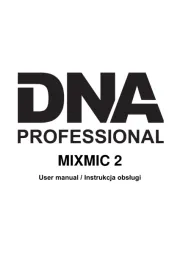
9 September 2025
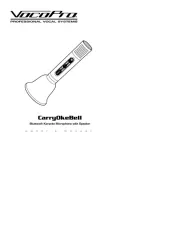
30 Augustus 2025
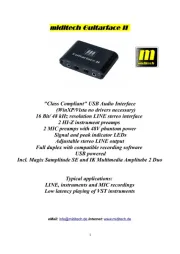
5 Augustus 2025
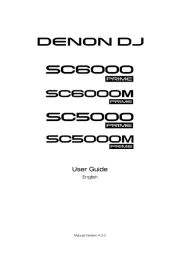
5 Augustus 2025
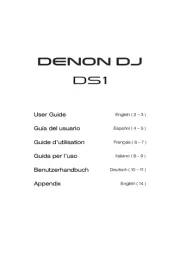
4 Augustus 2025
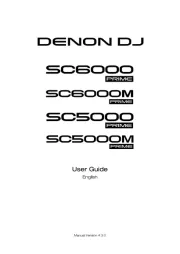
4 Augustus 2025
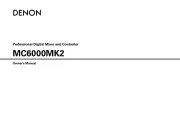
4 Augustus 2025
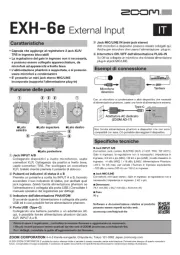
3 Augustus 2025
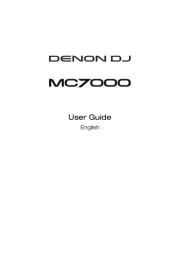
29 Juli 2025
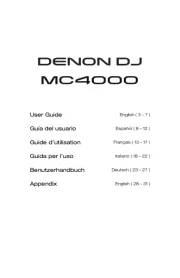
29 Juli 2025